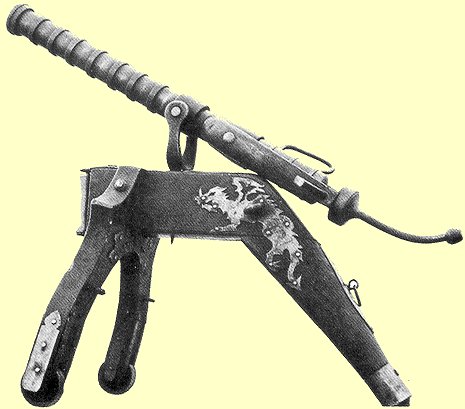Chinese Bombard
Today, a cannon that's two hundred years too old. The University of Houston's College of Engineering presents this series about the machines that make our civilization run, and the people whose ingenuity created them.
We used to think that the oldest cannons were the medieval bombards. They looked like big cast-iron pots. In fact, the French called them pots de fer, literally, pots of iron. They were pear-shaped with a narrow neck and a flared top. The oldest one we know is shown in a 1327 French manuscript. A knight in armor is applying a red-hot poker to its fuse. A spear-shaped projectile is about to be launched from its neck.
Historians have argued over the source of firearms. Before 1327 they find ambiguous hints of Arabic, Chinese, and European guns. We've found remains of a Chinese handgun from 39 years be-fore that French bombard picture. Old writings in the West mention earlier ordnance that might've used explosives. But, at best, they too go back only into the late 1200's.
In 1985 a visitor to a Buddhist cave in the Chinese province of Szechuan noticed something that other people had missed. There, carved on opposing walls, are groups of figures, eight of whom are armed to the teeth. One is a horned demon, holding what is unmistakably a bombard -- just like the one in the French drawing. Another holds a bomb. Both carvings are unambiguous. They even show flames exploding outward.
But there's a catch. These figures were carved in 1128 -- two centuries before the French bombard. Another interesting wrinkle: these figures form a kind of heavenly host. They stand on clouds and they include angels, armed and unarmed humans, as well as six demons. Only the demons hold the firearms.
A group of historians now offers this cave as evidence that the cannon went from China to Europe. And we must wonder why anything so important took so long to make the trip? They come to an odd conclusion. You need a lot of saltpeter to make good gunpowder, and the best source of medieval saltpeter was animal manure.
China had fewer domesticated animals than Europe, and the Chinese managed their use of animal waste and manure differently. The result was that saltpeter was harder to come by for the Chinese. Their gunpowder was made with too little saltpeter to be very powerful. Perhaps the bombard spread slowly in China because it was not a very effective weapon there.
The last crowning irony of these carvings is the intent of the cave itself. It was meant to propagate its builders' prayers for permanent peace. Inscriptions express the prayer "that weapons of war be forever stilled." The figures on the walls display all the weapons that the sculptors hoped would never be used.
Eventually, however, the bombards did come out of the cave, and out of China. Western armorers loaded them with far better powder and made them into a terrible weapon. This 850-year-old prayer for permanent peace reveals the beginnings of slaughter on a scale that those Buddhist monks could never have imagined.
I'm John Lienhard, at the University of Houston, where we're interested in the way inventive minds work.
(Theme music)
G-d Lu, J. Needham, and C-h Phan, The Oldest Representation of a Bombard. Technology and Culture, Vol. 29, No. 3, 1988, pp. 594-605.
This is a greatly reworked version of Episode 242.

Fifteenth-century Spanish canon called a caterara